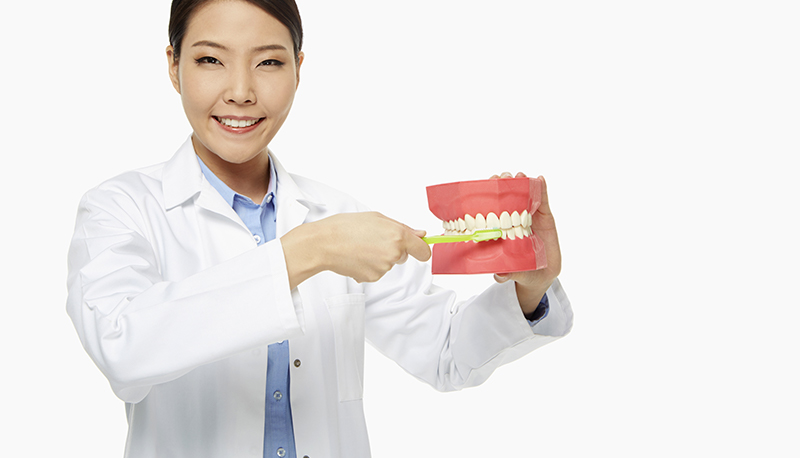Did you know that both toothpaste and mouthwash are over-the-counter (OTC) medicines? Brushing, flossing, and regular dental cleanings should be a key part of your healthcare regimen. Poor oral or dental hygiene can cause cavities and gingivitis, and has been linked with other health conditions.
Tips for Good Dental Hygiene
Here is some general information to help keep you smiling and healthy:
- Brush and floss twice a day, especially after eating
- Brush with a toothpaste that contains fluoride
- Use a soft toothbrush
- Floss with dental floss
- Have your teeth cleaned by your dental hygienist twice a year or as recommended by your dentist to prevent tooth decay and gum disease
- Avoid eating foods that stick between your teeth or foods that are high in refined sugar or acid
- Fluoride is a natural element that is extremely effective in preventing tooth decay and cavities. It can be found in toothpastes and mouthwashes, and is even added to the water supply in some communities
Fluoride Safe Use Tips for Parents
- Fluoride supplements should not be given to children 6 months old and younger
- Fluoride toothpaste should not be used with children under age 2
- Do not use too much fluoride. Use only a pea-sized amount of toothpaste for kids. (See important tips below.) Too much fluoride causes grey spots to appear on teeth and does not give additional strength to teeth. If you have any questions about the right amount, talk to your healthcare provider
- You should brush your child’s teeth until they are at least 6 years old. Once your child begins brushing their teeth themselves, you should still supervise as necessary to ensure they do not swallow the toothpaste and that they are learning good brushing and flossing habits until they are capable without monitoring
Safe Use Tips for Parents
- Start oral hygiene early in your child’s life
- Use a wet gauze pad to wipe your baby’s gums after each feeding to remove plaque and milk residue. Remember that “baby bottle cavities” can result when an infant is allowed to nurse continuously from a bottle of juice, milk, or sugar water when put to bed
- Soft bristled toothbrushes are recommended for children. A child’s toothbrush is smaller than an adult’s and is available in both a baby size (for children up to age 6 or 7) and a junior size (age 7 to 10)
- Children can usually remove plaque more easily with a brush having short and narrow bristles
- Mouth rinses and mouthwashes can cause serious illness and injury to children if they’re swallowed. These products should be kept out of the reach and sight of children
- Pay special attention to your oral care habits if you are pregnant or nursing and when your child begins teething
Safe Use Tips for Seniors
- Clean dentures thoroughly at least once a day to remove stains, debris, and potentially harmful plaque
- Use a combination of brushing and soaking
- Use only denture cleansers, not household cleaners, to soak your dentures. Household cleaners are not appropriate and may either be ineffective or damage denture material
- Denture cleanser tablets should never be chewed or swallowed, and never put denture cleaning solution in your mouth
- Cleaned dentures should be rinsed with water before being put back in your mouth, and the cleaning solution should be thrown out right away
- Consumers who have irritation or swelling of the throat or mouth after using a denture cleanser should remove dentures immediately; rinse their mouth with water; and call a dentist, other healthcare provider, or the poison control helpline at 800.222.1222 right away.
- Keep denture cleansers out of the reach and sight of children
- Use only moderate force when brushing. Brushing too hard can damage the acrylic resin most dentures are made of
Additional Information: Toothpaste Ingredients
Many toothpaste manufacturers produce toothpaste that contains the ingredient polyethylene, and several new products have been introduced in the past five years. In fact, more than 200 new polyethylene-containing toothpastes have been introduced in 43 countries by more than 15 manufactures worldwide.
Polyethylene is not absorbed by the body, and the body doesn’t create enzymes to break them down. The specks will pass through the digestive tract unchanged, similar to dietary fibers. Toothpaste should be used as directed, but even with some accidental ingestion, the polyethylene speck ingredients pose no safety risk. A patient’s normal oral care routine of brushing, flossing, and rinsing with water or mouth rinse should help clear the mouth of inert polyethylene specks.
Polyethylene is easily identifiable within the “inactive ingredient” list on the package carton.
There is no evidence from clinical studies or from post-marketing adverse event reporting to indicate that these particles persist underneath the gum line or cause harm.
Keep all medicines up and away and out of sight of children.
Not all products marketed under a brand contain the same ingredients. Please read the Drug Facts label carefully for active ingredient information.
Source: KnowYourOTCs
See also: Pain and fever

